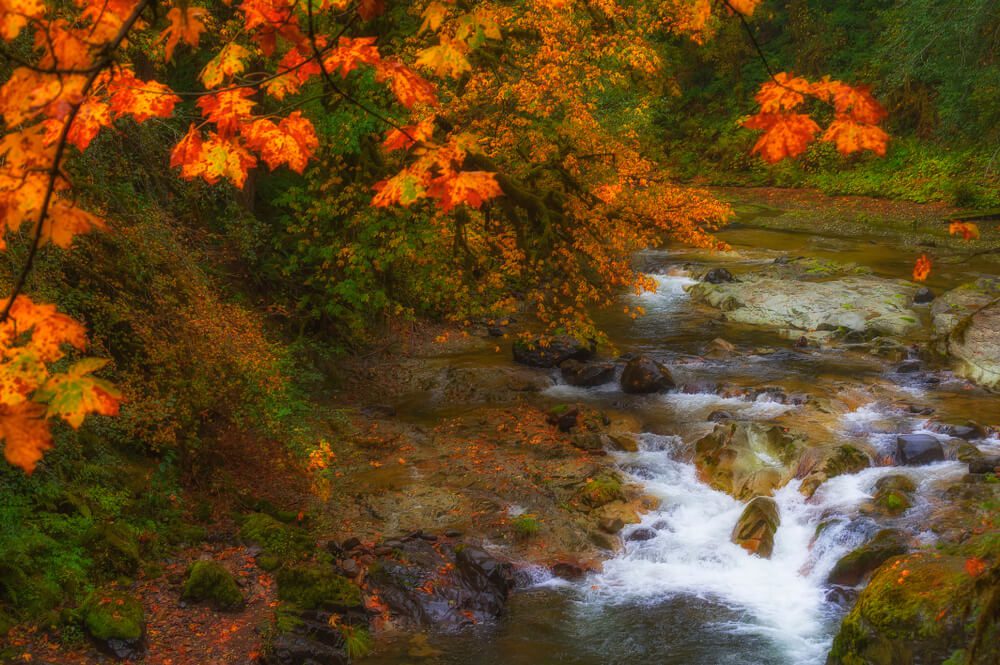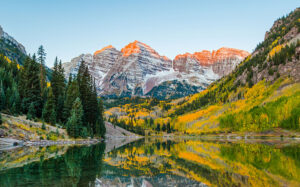The McKenzie Pass-Santiam Pass Scenic Byway is undeniably one of Oregon’s most beautiful drives, offering a spectacular journey through diverse landscapes that feel like several trips combined into one unforgettable experience. Having driven through the Pacific Northwest many times, what makes this road truly special is how it seamlessly transitions through mixed terrain—from ancient lava fields to dense forests, rushing rivers, cascading waterfalls, and breathtaking mountain views of six Cascade peaks. The 82-mile loop travels between the charming town of Sisters and Belknap Springs, and in the fall, the road transforms into one of the best places in the Pacific Northwest to witness the season’s spectacular changing colors. Golden aspens, fiery vine maples, and vibrant understory plants create a painter’s palette against the backdrop of volcanic landscapes and snow-capped mountains, making this drive an essential autumn adventure for anyone visiting Oregon.
Starting Point: Sisters, Oregon
The drive begins in Sisters, a small town that has captured hearts with its Western-themed downtown, antique shops, art galleries, and gateway location for countless outdoor adventures. Before hitting the road, take time to explore this charming community known for its creative spirit and mountain town atmosphere.
The road leaving town is lined with tall pines, and in the fall, the first glimpses of yellow and orange leaves start appearing among the trees, signaling the spectacular show ahead. The ponderosa pine forests create a beautiful contrast with the changing deciduous trees.
Oregon 242: Into Volcanic Territory
Continuing along Oregon 242, the scenery dramatically changes as dark lava fields stretch across the hillsides, revealing the volcanic history that shaped this part of the state thousands of years ago. This section of road climbs steadily, winding through a landscape that resembles something from another planet.
Dee Wright Observatory: A Historic Viewpoint
A popular stop here is the Dee Wright Observatory, built in 1935 by the Civilian Conservation Corps from the surrounding lava rock. This historic stone structure blends seamlessly with the volcanic landscape surrounding it. On a clear day, the observatory offers views of countless Cascade peaks, including the Three Sisters, Mount Washington, and Mount Jefferson.
The short walk around the observatory leads through the lava flows, with interpretive signs explaining the volcanic events that created this otherworldly landscape. Windows in the observatory are positioned to frame specific peaks, creating natural picture frames for the mountains.
Willamette National Forest: Mountain Lake Reflections
From McKenzie Pass, the road continues into Willamette National Forest, where even more mountain views open up through breaks in the forest canopy. The elevation changes bring different vegetation zones, each with its own autumn color palette.
Scott Lake: Mirror of the Mountains
One of the best stops here is Scott Lake, which reflects the Three Sisters peaks in its calm water. On a clear day, especially during the still morning hours, it feels like looking into a perfect mirror—a favorite spot among photographers and one of the most memorable views along the entire route.
The lake sits at approximately 5,000 feet elevation, and the surrounding area offers opportunities for short walks along the shore. In fall, the reflection of autumn colors combined with the mountains creates photography opportunities that draw visitors from across the region.
Highway 126: Waterfall Country
Next, the drive takes you onto Highway 126, leading to some of the area’s most popular waterfalls. This section descends through old-growth forests where moss-covered trees and ferns create a lush, green backdrop even in autumn.
Koosah and Sahalie Falls Trail
Stop at the Koosah and Sahalie Falls Trail, a roughly 2.6-mile loop that takes you past both powerful waterfalls. These falls are fed by the McKenzie River, which emerges from nearby Clear Lake as crystal-clear, ice-cold water.
Sahalie Falls plunges 100 feet in a thundering cascade, while Koosah Falls drops 70 feet in a more delicate, multi-tiered display. The trail connecting both falls offers several viewpoints, each revealing different perspectives of these natural wonders. The mist from the falls creates micro-climates where ferns and mosses thrive.
Santiam Pass: Final Mountain Views
From there, continue along Santiam Pass, passing the Hoodoo Ski Area and heading toward Suttle Lake, which is framed by vine maples that turn bright hues of orange, red, and yellow in autumn. This lake offers a different character than Scott Lake—more accessible and developed, with opportunities for paddling and lakeside walks.
The Santiam Pass area sits at the watershed divide between the McKenzie River and the Santiam River drainages, creating unique ecological conditions. The ski area provides a reminder that this same road becomes a winter playground once snow arrives.
Completing the Loop
The drive loops back to Sisters, and without stops, it takes about two hours to complete the circuit. But if you want to take your time, explore a few trails, and snap plenty of photos, plan for three to four hours so you can fully enjoy the scenery at a relaxed pace.
Many visitors find that allowing a full day to explore side trails, enjoy picnic stops, and really absorb the diverse landscapes makes for the most rewarding experience.
Seasonal Considerations: Why Fall is Perfect
The McKenzie Pass section of the byway closes in winter due to its high elevation and snowy conditions, typically starting in early November. That makes fall the perfect time to visit, when the vibrant foliage contrasts beautifully with snow-dusted peaks in the distance.
Peak Fall Color Timing
The fall colors typically peak in late September through mid-October, though exact timing varies by elevation and weather patterns. Higher elevations show color first, with the progression moving downward as temperatures drop.
Lower elevations along Highway 126 may show peak color slightly later than the higher McKenzie Pass section. Checking local foliage reports before your visit helps ensure you catch the most vibrant displays.
Planning Your Visit
Best Time of Day
Morning light offers the best conditions for photography, with soft golden light illuminating the peaks and creating optimal conditions for lake reflections. Weekday visits mean fewer crowds at popular stops like the Dee Wright Observatory and Scott Lake.
Late afternoon light, especially the hour before sunset, creates dramatic lighting conditions on the lava fields and mountain faces. However, be mindful that autumn days are shorter, and you’ll want to complete the drive before darkness falls.
What to Bring
Oregon weather can be unpredictable, especially at higher elevations. Bring layers, as temperatures can vary significantly between Sisters (around 3,200 feet) and McKenzie Pass (5,325 feet). Even on warm valley days, the pass can be surprisingly cool, especially with wind.
Essential items include:
- Layered clothing for changing temperatures
- Sturdy walking shoes for trails and lava field exploration
- Camera with extra batteries (cold drains batteries faster)
- Water and snacks (limited services along the route)
- Full tank of gas (fuel up in Sisters)
- Binoculars for distant peak viewing
- Sunscreen and sunglasses (high elevation sun is intense)
Road Conditions
Oregon 242 over McKenzie Pass is a narrow, winding road with no center line in many sections. The road was never designed for large RVs or trailers—in fact, vehicles over 35 feet are prohibited. The lack of guardrails in some sections requires careful attention to driving.
Check current road conditions before departing, as the road can close suddenly due to weather. The Oregon Department of Transportation (ODOT) website provides up-to-date closure information.
Additional Stops and Side Trips
Clear Lake
Just off Highway 126, Clear Lake lives up to its name as one of Oregon’s clearest bodies of water. The lake formed when lava flows dammed the McKenzie River about 3,000 years ago. You can still see preserved trees standing underwater, visible through the remarkably clear water.
A 5-mile trail circles the lake, offering views of the submerged forest and autumn reflections. Canoe and kayak rentals are available for those wanting to paddle across the glassy surface.
Blue Pool
This lesser-known gem along the McKenzie River features impossibly blue water in a small pool fed by underground springs. A short trail leads to viewing platforms where you can observe the vivid blue water contrasting with autumn foliage.
Proxy Falls
Though not directly on the byway, a short detour leads to Proxy Falls, a stunning waterfall that fans out over a moss-covered cliff face. The 1.3-mile loop trail offers both lower and upper falls viewing, with the upper falls being particularly photogenic in autumn.
Wildlife Watching Opportunities
The McKenzie Pass-Santiam Pass Scenic Byway traverses diverse habitats supporting varied wildlife. Watch for black-tailed deer grazing in meadows near Suttle Lake, and keep eyes skyward for red-tailed hawks and occasionally golden eagles riding thermal currents above the lava fields.
The forests harbor Douglas squirrels (chickarees), whose chattering often announces your presence to other forest creatures. Mountain areas might reveal evidence of black bears, though sightings are rare as they forage for food before winter hibernation.
Photography Tips
The diverse landscapes along this scenic byway offer endless photography opportunities. For lava field shots at Dee Wright Observatory, midday light works well, highlighting the textures and colors in the volcanic rock.
Lake reflections at Scott Lake require calm conditions—visit early morning for the best mirror-like surfaces. Bring a polarizing filter to reduce glare and enhance autumn color saturation.
Waterfall photography benefits from slower shutter speeds to create that silky water effect. Bring a tripod and consider using ND filters if shooting in bright conditions.
Nearby Accommodations
Sisters offers the most lodging options, from chain hotels to charming bed and breakfasts. Booking ahead during fall color season is essential, as the town fills quickly with leaf-peepers and outdoor enthusiasts.
Alternative bases include Bend (20 miles east) with more extensive lodging and dining options, or Belknap Springs on the west side, featuring hot springs resort accommodations for post-drive relaxation.
Dining Recommendations
Sisters provides diverse dining options, from casual cafes to upscale restaurants. Three Creeks Brewing Company offers excellent craft beer and pub fare with views of the mountains. For breakfast, the Sisters Coffee Company serves excellent coffee and pastries to fuel your drive.
Pack picnic supplies before departing, as there are no restaurants or stores along the byway itself. Several scenic spots make perfect picnic locations, including Scott Lake and the lava fields near Dee Wright Observatory.
Conservation and Leave No Trace
This beautiful byway receives heavy use during peak season. Practice Leave No Trace principles by staying on designated trails, packing out all trash, and respecting wildlife by observing from appropriate distances.
The lava fields may look barren, but they support fragile ecosystems adapted to harsh conditions. Stay on marked paths to protect these slowly recovering volcanic landscapes.
Why This Drive Stands Out
The McKenzie Pass-Santiam Pass Scenic Byway offers what few roads can—dramatic landscape diversity compressed into a manageable distance. You’ll experience alpine environments, volcanic moonscapes, old-growth forests, and cascading rivers all in one journey.
The fall season adds another dimension, with autumn colors providing warm tones that complement the cool grays of lava rock and the white of distant snow. It’s a drive that rewards both quick passes and leisurely full-day explorations.
Whether you’re a serious photographer chasing perfect light, a nature lover seeking seasonal beauty, or simply someone who appreciates stunning scenery from behind the wheel, this Oregon scenic byway delivers an unforgettable experience that captures the essence of the Pacific Northwest‘s natural grandeur.
Discover more scenic drive recommendations, seasonal travel guides, and Pacific Northwest exploration tips at The Inspiring Insight—where we help you find the roads less traveled and the views that take your breath away in destinations across the country.


